 Leading Blog | Posts by Month |
 Leading Blog | Posts by Month |
08.31.08

Five Myths about the Oil and Gas Industry In the final chapters of The First Billion Is the Hardest, T. Boone Pickens dispels five myths about the oil and gas industry: Myth No. 1: Drilling in the Arctic National Wildlife Refuge will make us energy dependent. Myth No. 2: Ethanol will save the day. Myth No. 3: Big Oil is manipulating the price of gas at the pumps. Myth No. 4: The lack of new refineries in the United States is a main contributor to high gasoline prices. Myth No. 5: New Technology will enable us to discover enormous untapped reservoirs of oil. He writes, “We are going to be dependent on oil for at least another fifty years; that means foreign oil, ad that means trouble. Either we need to be prepared to face those consequences or we need to get working on some alternatives.” He adds, “Our biggest problem is leadership.”
Posted by Michael McKinney at 06:58 PM
08.29.08

An Interview with John Kotter on Urgency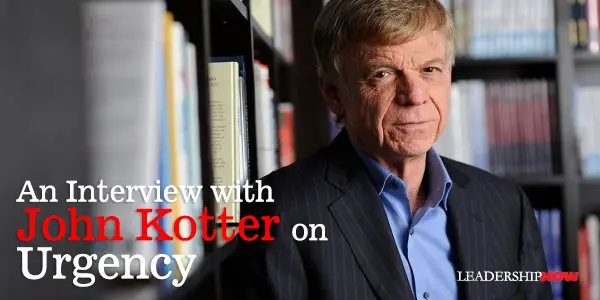
John P. Kotter, Konosuke Matsushita Professor of Leadership, Emeritus at Harvard Business School, is widely regarded as the world's foremost authority on leadership and change. His is the premier voice on how the best organizations actually "do" change. In his newest work, A Sense of Urgency, Kotter shows what a true sense of urgency in an organization really is, why it is becoming an exceptionally important asset, and how it can be created and sustained within organizations. LeadingBlog: Behind urgency seems to be this tension between where you often begin—fear—and then moving on from there to something more positive. It seems like the quickest way to engage people’s emotions is through fear and anger. But as you state in your book “fear and anger can kill hope and stop the growth of a true sense of urgency.” Is it realistic to think that fear and/or anger will completely disappear? Or that we would even want it to? John Kotter: First of all, there are ways to grab people without fear and anger. You can move a complacent group out of complacency without the fear and anger; without hitting them on the top of the head or without jumping out of a closet with a gorilla suit on. But having said that, in some situations that can be effective. The issue is precisely the issue that you raised—some people think that once you’ve got that, you’ve got it. You drive them off their burning platform or whatever with a flaming whip. The reality is it doesn’t work well. Because if you’re trying to get action going—especially if it’s new action and if it’s dealing with an increasingly fast-moving world—fear ultimately drives people to be self-protective, they hide underneath their desks so to speak. Fear turns to anger easily because they’re mad that somebody is scaring them to death. Mad people go and look for grenades and guns. None of that helps. And so when you find people who are trying to, for example, drive a group out of complacency into a state of real urgency to where they can start making something happen if indeed step one is shaking them up in that negative sense, they use that only as kind of a wake-up. It’s a jarring alarm clock that sets a foot out of bed—almost trembling because you wonder if the bomb is going to hit or something. But as quickly as possible they start using methods, if you will to turn those emotions into a kind of positive determination to deal with the very real problems or sometimes opportunities that they had not been dealing with. It’s possible. If you don’t do it, you just get the fear and anger going and you don’t get anywhere. And worse case, it snaps back at you. You know, the people are so angry they burn down your own castle. LB: Obviously you can't create an environment where every day is a fire drill. And there is the notion than if everything is urgent then nothing is really urgent. How do you counteract that perception? JK: Your “every day is a fire drill” comes close to what I call false urgency; which isn’t urgency. False urgency again is very much driven more by fear and anger than anything else. It’s activity not productivity. It’s racing out of the firehouse whether there’s a fire or not. Every day it’s meeting, meeting, meeting—PowerPoint, PowerPoint, PowerPoint—until we’re all so stressed out and exhausted that who can be urgent about anything. If you’re kind of crawling home with your tongue down and stress level at 10—that’s clearly not what organizations need these days. Real urgency is at the intellectual level it's a grasp that there are huge opportunities in the hazards out there, not just your department or outside your office but outside the organization. And more importantly its that kind of emotional, gut-level determination that you’re going to grab stuff and win and do it now. It’s kind of “I’m going to get up every single day and on these very real, big issues that are out there, (not some trivial little junk that surrounds my political arena) I’m going to accomplish something today and make us collectively win.” And that leads just naturally to a hyper-alert behavior. It leads to just faster movement. It leads people because they care so much about winning and doing it now, that if they start becoming overloaded they don’t just stress out and pass out—they care too much. They know that that isn’t going to accomplish anything so they start looking at their agendas and getting rid of the junk that clogs almost all of our appointment calendars or delegating it (if they are in senior positions) so they’ve got the time to deal with it without being exhausted. If you are really determined to make an organization win there is no way you going to win by playing parochial politics—it might help your career a little bit (and some people, of course, do that) but essentially … urgency is a win. For example, my Celtics who happened to win, as we all know, the NBA championship this year. The announcers were relentless in the last game saying that the critical key was that the coach was able to get these guys not to think in terms of “Well, the probability is very high with home-court advantage that we’re going to pull this off”—forget all that stuff—the idea is for us—big underline us—that there’s no way in the world that we’ll win that championship which people emotionally want, unless we get up every day prepared to win the first quarter and the second quarter and then the third quarter, then the fourth quarter. That’s the mindset. And indeed it worked for the Celtics and it works for companies too. The problem is that most companies don’t have nearly enough of that. And it gets more troublesome as the world changes faster around them. LB: Well then the intensity varies naturally. As you said, it’s not a fire drill; it’s not reactive so automatically it varies the intensity based on what you can do that day based on the realities of the situation. JK: Yeah, yeah, yeah. And there’s nothing wrong with this mindset to get up and discover that. You’re realistic and the only thing you can do that day that kind of pushes the agenda in some significant way—not trivial way—is what you say at the end of a meeting. It’s basically a five-minute little thing in a ten-hour day. But you’ve found your five minutes, right? You didn’t just say, “Well there’s nothing I could do today.” And the five minutes is focusing on something that really is important and is helping you collectively win. There are going to be days like that. There are going to be other days where because of the nature of the agenda, who’s around etcetera, etcetera, almost all the day is just pounding away at some critical possibilities for dealing with these big issues. But again, if the emotional set is right—it’s this kind of grinding determination that you just going to make it win. Even in the long day, you obviously come out tired but it is with a fulfilling feeling. LB: When people perceive that everything around them is changing, is it possible to create a sense of stability and at the same time a sense of urgency? JK: I think to some degree, you’ve got to have some stability or very few people can handle it. Very few people can live in a tornado. And as it turns out, if you think about it, it’s not hard to do. It’s almost a perceptual thing. Because you could sit down with somebody, for example, who is saying, “This is nuts. We can’t have this much change going on.” So you say, “Alright, let’s think that one through. Let’s be very literal. What time did you get up this morning?” What does that have to do with anything?” “Just bear with me.” “OK, seven o’clock.” “What time did you get up yesterday?” “Well, around seven.” “What time did you get up the day before?” “OK nothing changed. Did you have coffee this morning?” “Yeah, so what?” “Did you have coffee yesterday morning?” “Yeah, so what?” “Nothing changed.” You can play this game—and I don’t mean a game. A game sounds negative. What you’ll describe, is for most of us, the vast majority of things we do, we did yesterday, the day before and the day before that. In other words, there’s a great stability in all of our lives. But when things start to change on a certain dimension it feels as if we’re in a tornado. And if you can help people to realize that no we’re not floating in air getting ready to be slammed into a wall. As a matter of fact this building hasn’t changed, we still walk from room to room, we’re in a very stable situation. In many, many ways it just that on a few dimensions we’re changing a lot more than we did in the past. The world it feels like “Whoa!” Stability is important, but to some degree it is a perceptual thing. And by the way, the vast majority of things we do aren’t different. I think a lot of it is the rate of change issue. We’re used to the rate of change being x then all of a sudden it’s 4x. The body kind of likes equilibrium and so it kind of goes “Whoa!” And if you can calm it down by pointing out what’s happening. Relax. It’s mostly fable. We can handle this. We can handle this little bit of change. It just feels wild. You can’t just give the two-minute speech I gave you and think that everything is going to be fine. But there is a way to help people to appreciate that reality that I’ve described very tersely. LB: You keep expressing it. JK: Yes, a lot of these things, it’s saying it again and again. You say it in a different way, and you say it again at another time, and after a while, it starts to sink in. 
Posted by Michael McKinney at 09:10 AM
08.27.08

5 Leadership Lessons: Axiom: Powerful Leadership Proverbs
Posted by Michael McKinney at 06:24 AM
08.25.08

Reality Always WinsLeading With Kindness could just as well have been titled, Leading With Respect – respect for others and ultimately a healthy self-respect. Leadership, if properly practiced, is not made effective by harsh or oppressive treatment. Major General John Schofield put it this way in an address to the Corps of Cadets at West Point in 1879:He who feels the respect which is due others cannot fail to inspire in them regard for himself, while he who feels, and hence manifests, disrespect toward others, especially his inferiors, cannot fail to inspire hatred against himself.Honesty and integrity is about respect for others. Its expression is a manifestation of that respect. Dishonesty is disrespect. Dishonesty comes in all shapes and sizes, but the authors, Baker and O’Malley, reminds us, “dishonesty is a fundamental failure to recognize the existing facts, regardless of whether you deceive yourself or others….The truth always has a way of expressing itself in the end. But this end is often too late. Success in life as within the corporation requires a respect for reality from the start.” How an organization conducts is business is a clear sign to employees as to what is expected of them—or more to the point, what they can get away with. “Perhaps the most obvious reason people within organizations cheat and lie is because either it is in their short-term interest (usually financial) to do so, or they are covering up unethical behavior.” In order to offset the temptations in the system for personal gain or punishment avoidance, the authors offer these suggestions:
Posted by Michael McKinney at 06:41 AM
08.22.08

What Do You Mean “Urgent Patience”?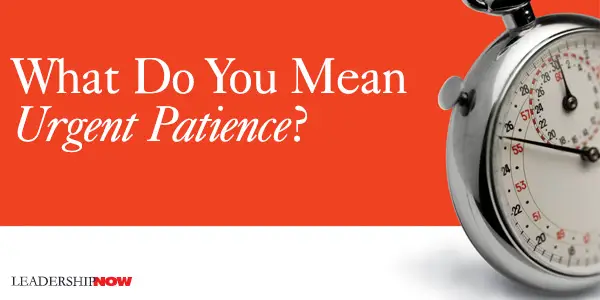
 Behaving urgently does not mean constantly running around. Screaming “Faster-faster,” creating too much stress for others, and then becoming frustrated when no one else completes every goal tomorrow. That is false urgency. People who understand the basics—a faster-moving world, the need for more urgency—fall into the false-urgency trap far too often. 
Posted by Michael McKinney at 08:38 AM
08.20.08

How to Develop and Maintain a Sense of Urgency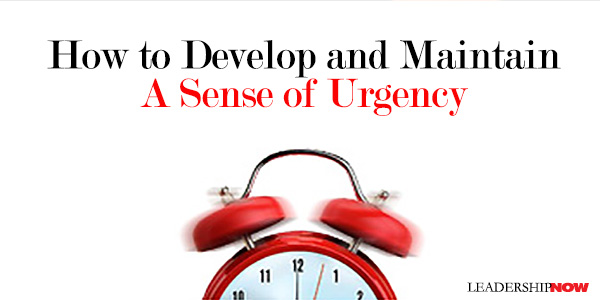
LEADERSHIP and change expert John Kotter finds that the number one problem organizations face when trying to execute change is creating a sense of urgency. Unfortunately, that is the first step in a series of actions needed to succeed in bringing about change. In a time when the rate and type of change is increasing exponentially, organizations (and individuals) can not afford to get (or remain) complacent. In A Sense of Urgency, Kotter states that a true sense of urgency is rare mainly because “it is not the natural state of affairs. It has to be created and recreated.” More often than not, what passes as urgency is more likely a false urgency that he describes as the “unproductive flurry of behavior” built on “a platform of anxiety and anger.” True urgency is different. Is understood by the head (intellectually) but driven by the heart (emotions). It is externally focused and expressed in daily behaviors that move relentlessly toward the target, ever alert to changing conditions and weeding out superfluous activity. Kotter offers four tactics to establish a sense of urgency in any environment: First, bring the outside in. A “we know best” culture reduces urgency. “When people do not see external opportunities or hazards, complacency grows…. With an insufficient sense of urgency, people don’t tend to look hard enough or can’t seem to find the time to look hard enough. Or they look and do not believe their eyes, or do not wish to believe their eyes. Even if seen correctly, and in time, external change demands internal change.” The second tactic is to behave with urgency every day. “Increasingly changing environments create a need for alertness and agility, which demands a sense of urgency that must be modeled by the boss all the time.” A few of the behaviors he details: purge and delegate, speak with passion, walk the talk. Third, find opportunity in crises. A problem with a damage control mind-set is it often eliminates an opportunity. A properly leveraged crisis can be a valuable tool to break through complacency. And fourth, deal with the NoNos – those people that are “always ready with ten reasons why the current situation is fine, why the problems and challenges others see don’t exist, or why you need more data before acting.” Your greatest tool for maintaining urgency is the knowledge that “urgency leads to success leads to complacency.” Keeping up the urgency to stay the course to a long-term goal or to maintain a high level of performance in the face of short-term gains requires a conscious reworking of the four tactics again and again. “Acting Urgently is the tactic that creates results quickly. The other three tactics can all be started immediately, but will take time.”Kotter provides many examples made helpful by his insight. He extracts tips and behaviors that will guide you in developing a culture of urgency in your organization (and life). 
Posted by Michael McKinney at 05:34 PM
08.18.08

Positive Leadership
The ideas are not necessarily new but the emphasis is. The focus is on the role of leaders in enabling positive deviant performance or outcomes that dramatically exceed common or expected performance. Cameron says that most organizations focus on maintaining performance that is predictable and steady. He is talking instead, about creating an organization that is not just coping but is flourishing (positive deviancy). Creating an organization where people can positively exceed expectations is highly coveted any time, but is more important in difficult times. Flourishing organizations and breakout performance requires positive deviancy—going beyond the norm in a positive direction. The idea is that individuals and organizations produce life-giving and flourishing outcomes when organizational strategies are based on the positive. (think Heliotropic Effect) He writes: In sum, positive leadership refers to an emphasis on what elevates individuals and organizations (in addition to what challenges them), what goes right in organizations (in addition to what goes wrong), what is life-giving (in addition to what is problematic or life-depleting), what is experienced as good (in addition to what is objectionable), what is extraordinary (in addition to what is merely effective), and what is inspiring (in addition to what is difficult or arduous). He presents four of the most important, interrelated, and mutually reinforcing strategies that leaders can implement in an organization. (These ideas work in families as well.) They are shown below: 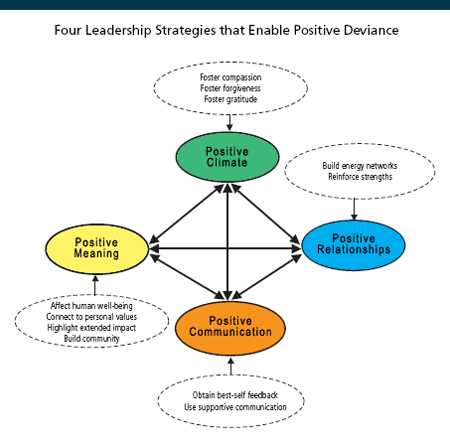 Positive Climate: “Leaders significantly affect organizational climate as they personally induce, develop, and display positive emotions.” Research cited in the book concludes that inducing positive emotions “broaden people’s momentary thought-action repertoires and builds their enduring personal resources.” Conversely, “Negative emotions narrow people’s thought-action repertoires and diminish their coping abilities.” Positive Relationships: People in positive social relationships, “significantly outperformed acquaintance groups on both decision-making and motor tasks.” Interestingly, “Relationships that help people contribute to the benefit of others, rather than merely receive support from them, are the most valuable.” Positive Communication: “The single most important factor in predicting organizational performance—which was more than twice as powerful as any other factor—was the ratio of positive statements to negative statements.” And we’re not talking about 100 to 1 here. Research revealed that the ratio was about 5 to 1 in high-performing organizations. There is a time and place for constructive negative communication. Positive Meaning: “Reinforcing the benefits produced for others, associating work outcomes with the core values of employees, identifying the long-term impact created by the work, and emphasizing contribution goals more than achievement goals all foster a sense of meaningfulness and, as a result, higher levels of performance.” Each chapter ends with a quick assessment of the activities that foster that particular strategy. It will help you identify those areas where you are succeeding and identify areas where you could implement additional behaviors. Also described is a helpful technique for implementing the four strategies called the Personal Management Interview program. The final chapter provides a self-assessment instrument and a guide for implementing the four strategies.Positive Leadership is a short book, but it's long on vital information that a leader in any context would benefit from. While based in empirical research, the ideas presented here will resonate with you. Practiced, they will greatly benefit your corner of the world. 
Posted by Michael McKinney at 08:30 PM
08.14.08

Out of Context: The Lengthened Shadows of Leaders"A company doesn't fail to do anything. Individuals do, and when you probe a bit you usually find that failure lies not in a litany of strategic mistakes - though they may all be present in one form or another - but the real fault lies, as Shakespeare noted, in ourselves, the leaders of the business. Businesses are the product and the extension of the personal characteristics of its leaders - the lengthened shadows of the men and women who run them." —Donald R. Keough
The Ten Commandments for Business Failure
Posted by Michael McKinney at 09:10 AM
08.12.08

Are You Having a No-Good, Very-Bad Day?
IF YOU are like most of us, anything going on but what you want, warrants a complaint. Not an action-oriented, let’s get this solved kind of complaint, but your everyday run-of-the-mill mindless kind of complaining that leads nowhere (except to more negative thinking). Jon Gordon, author of The No Complaining Rule, says there are two main reasons why we complain: (1) because we are fearful and feel helpless and two, because it has become a habit. He urges us to outgrow the complaining habit. He cites a Gallup poll that finds that negativity costs companies nearly $300 billion each year. “In life,” Gordon writes, “you have a choice between two roads. The positive road and the negative road. The positive road will lead to enhanced health, happiness, and success and the negative road will lead to misery, anger, and failure. Since your bus can’t be on two roads at the same time, you must decide which road you want to be on. And when you complain you travel down the negative road.” “In life,” Gordon writes, “you have a choice between two roads. The positive road and the negative road. The positive road will lead to enhanced health, happiness, and success and the negative road will lead to misery, anger, and failure. Since your bus can’t be on two roads at the same time, you must decide which road you want to be on. And when you complain you travel down the negative road.” As former chronic complainer, Gordon effectively delivers his message through a story. The No Complaining Rule doesn’t rule out complaining – it requires that it be constructive. Employees are not allowed to mindlessly complain to their coworkers. If they have a problem or complaint about their job, their company, their customer, or anything else, they are encouraged to bring the issue to their manager or someone who is in a position to address the complaint. However, the employees must share one or two possible solutions to their complaint as well.Gordon explains how do develop a positive culture by creating a culture where negativity can’t breed, grow, and survive. A crucial key is to all this is to focus on gratitude. “Research shows that when we count three blessings a day, we get a measurable boost in happiness that uplifts and energizes us. It’s also physiologically impossible to be stressed and thankful at the same time. Two thoughts cannot occupy our minds at the same time. If you are focusing on gratitude, you can’t be negative. You can also energize and engage your coworkers by letting them know you are grateful for them and their work.” Start a revolution in your own life, at work, and at home. Download free No Complaining Rule posters and other tools from Jon Gordon’s web site. Have no complaining day! 
Posted by Michael McKinney at 09:22 PM
08.08.08

5 Leadership Lessons: Jim McNerney’s Top Tips For Implementing Innovation 
Posted by Michael McKinney at 07:48 PM
08.06.08

Can You Lead With Kindness?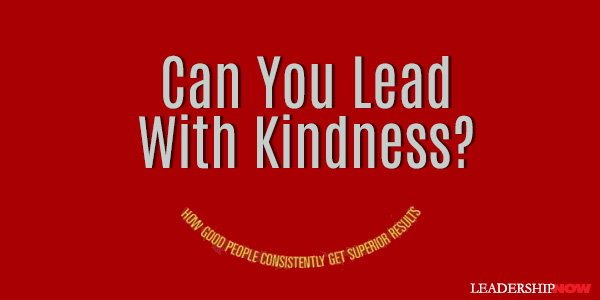
Bill Baker and Michael O’Malley have done a service with their book, Leading With Kindness. As awkward as that title might seem at first blush, the authors aren’t suggesting that kind leaders have a soft personality, or are sissies, or are well liked at all times. (“You can be hard-nosed and kind.”) Leading with kindness is not a hot-tub leadership where the participants pass the torch singing Kumbaya. In fact they write, “They muddle through life much like the rest of us, mostly unnoticed except by those around them who are keenly aware that they are in the presence of someone special.” (That last sentence reminds me that great leaders are not great because they are super-human. Instead, they are ordinary but growth-oriented people with character that have chosen to make a commitment to a bold course of action that is in the best interest of those they serve despite the odds.) The authors add: The fact is, kindness isn’t always nice. It pushes others to do better; it asks them to try out things that they are uncertain they can accomplish; it requires them to engage in activities that they are not sure they will like. Another fact is this: Folks don’t always take kindly to kindness. Leaders, even great ones, cannot save everybody. Armed with that knowledge, you can safely leave the dust-jacket on when you read the book and confidently move on absorbing the many great insights the book has to offer. The book is research-based, practical and realistic. They suggest that:
Baker and O’Malley ascribe six attributes and behaviors to leading with kindness:
In the end, it gets down to character, maturity and a genuine respect for other people. Kindness is a way of viewing the world and it can only come from within. 
Posted by Michael McKinney at 01:58 PM
08.04.08

Are You a PITA?
I first heard the term PITA (Pain In The Ass) when referring to clients or coworkers from friend and international consultant to accountancy firms, Chris Frederiksen (The 2020 Group), in his seminar, How To Build A Million Dollar Practice in the early 80s. It resonated with everyone there as Robert Orndorff’s and Dulin Clark’s new book, The PITA Principle: How to Work With (and Avoid Becoming) a Pain in the Ass, will resonate today with anyone that has had experience working with groups of people anywhere. Mention PITA and no doubt someone’s name or face will pop into your head. They define PITAs as those “folks who arouse our emotions, challenge our patience, and make us labor for our money on a daily basis.” Their goal in mentioning this is two-fold. First, they want to give you some coping strategies to help you deal more effectively with those people. Secondly, they want you to avoid being on someone else’s PITA list. We can all be PITAs from time to time, but by promoting a little self-awareness, they hope to help you to either avoid or emerge from being a PITA. This second goal is not an easy task. Heightened self-awareness, or lack of, appears to mystify some of society’s most prominent figures, from the corporate executive who unknowingly yet chronically berates his employees through abuses of power, to the physician who patronizes her patients through her intellectual arrogance to the politician who cannot and will not admit mistakes in judgment out of ego-preserving stubbornness. The authors note that those people who refuse to take the time to gain a little self-awareness and learn to soften or manage their PITA tendencies, “don’t get the importance of developing the other side of themselves because they are either too self-absorbed, too unaware, or too defensive to let other information enter into their consciousness.” This is a prescription for self-destruction. They describe eight types of PITAs in detail and offer some coping strategies for each and advice to help you get some perspective on their behavior. You’ll also find a selection of ten more PITA types that get honorable mention. 
Posted by Michael McKinney at 07:58 AM

What Are Your PITA Tendencies?To get you started in your own PITA self-discovery we offer this assesment from Robert Orndorff's and Dulin Clark's book The PITA Principle They write, "Just as some PITA types are tougher to work with than others, you'll have greater potential or tendencies to behave like certain PITA types more so than others.To take this quiz you will need to print this page from this post's permalink page or simply write your answers on a separate piece of paper. Use the following scale to enter the number that most closely reflects your feelings. After answering all of the questions, score the total sum for each PITA type according to the instructions given below.
Quiz Questions
PITA Quiz Score Sheet Scoring Your Responses For each PITA type below, add the scores from the survey for the question numbers listed next to each PITA type. Place the total on the line in front of each type. High scores indicate that you might have potential for behaving like that type of PITA in various work situations.
After determining your PITA tendencies, you will want to refer to the corresponding chapter in the book that describes your PITA type in more detail. The authors maintain a PITA blog. Categories: Leadership Development
Posted by Michael McKinney at 07:56 AM
08.01.08

Leadership Books: August 2008Here's a look at some of the best leadership books to be released in August.




Posted by Michael McKinney at 07:29 AM
|
BUILD YOUR KNOWLEDGE


How to Do Your Start-Up Right STRAIGHT TALK FOR START-UPS 
Grow Your Leadership Skills NEW AND UPCOMING LEADERSHIP BOOKS 
Leadership Minute BITE-SIZE CONCEPTS YOU CAN CHEW ON 
Classic Leadership Books BOOKS TO READ BEFORE YOU LEAD |
|